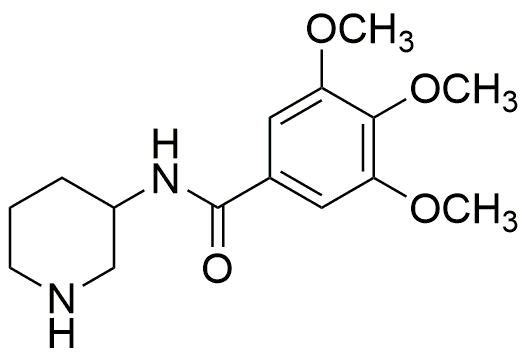Troxipide is widely utilized in research focused on:
- Gastrointestinal Health: Primarily used in the treatment of gastric disorders, it helps in reducing gastric acid secretion and promoting mucosal healing, making it beneficial for patients with ulcers.
- Pharmaceutical Development: Troxipide serves as a model compound in drug formulation studies, aiding researchers in understanding drug interactions and bioavailability in the gastrointestinal tract.
- Animal Health: Its application extends to veterinary medicine, where it is used to treat similar gastrointestinal issues in animals, ensuring better health management in livestock.
- Research on Mucosal Protection: The compound is studied for its protective effects on the gastric mucosa, providing insights into new therapeutic strategies for preventing gastric damage.
- Comparative Studies: Troxipide is often compared with other gastroprotective agents, offering researchers a unique perspective on efficacy and safety profiles in clinical settings.
Información general
Propiedades
Seguridad y normativas
Aplicaciones
Troxipide is widely utilized in research focused on:
- Gastrointestinal Health: Primarily used in the treatment of gastric disorders, it helps in reducing gastric acid secretion and promoting mucosal healing, making it beneficial for patients with ulcers.
- Pharmaceutical Development: Troxipide serves as a model compound in drug formulation studies, aiding researchers in understanding drug interactions and bioavailability in the gastrointestinal tract.
- Animal Health: Its application extends to veterinary medicine, where it is used to treat similar gastrointestinal issues in animals, ensuring better health management in livestock.
- Research on Mucosal Protection: The compound is studied for its protective effects on the gastric mucosa, providing insights into new therapeutic strategies for preventing gastric damage.
- Comparative Studies: Troxipide is often compared with other gastroprotective agents, offering researchers a unique perspective on efficacy and safety profiles in clinical settings.
Documentos
Hojas de datos de seguridad (HDS)
La SDS proporciona información de seguridad completa sobre la manipulación, el almacenamiento y la eliminación del producto.
Especificación del producto (PS)
La PS proporciona un desglose completo de las propiedades del producto, incluida la composición química, el estado físico, la pureza y los requisitos de almacenamiento. También detalla los rangos de calidad aceptables y las aplicaciones previstas del producto.
Certificados de análisis (COA)
Busque certificados de análisis (COA) ingresando el número de lote del producto. Los números de lote y de partida se pueden encontrar en la etiqueta de un producto después de las palabras "Lote" o "Lote".
Número de catálogo
Número de lote/lote
Certificados de origen (COO)
Este certificado de origen confirma el país en el que se fabricó el producto y también detalla los materiales y componentes utilizados en él y si se deriva de fuentes naturales, sintéticas u otras fuentes específicas. Este certificado puede ser necesario para cumplir con las normativas aduaneras, comerciales y regulatorias.
Número de catálogo
Número de lote/lote
Hojas de datos de seguridad (HDS)
La SDS proporciona información de seguridad completa sobre la manipulación, el almacenamiento y la eliminación del producto.
DownloadEspecificación del producto (PS)
La PS proporciona un desglose completo de las propiedades del producto, incluida la composición química, el estado físico, la pureza y los requisitos de almacenamiento. También detalla los rangos de calidad aceptables y las aplicaciones previstas del producto.
DownloadCertificados de análisis (COA)
Busque certificados de análisis (COA) ingresando el número de lote del producto. Los números de lote y de partida se pueden encontrar en la etiqueta de un producto después de las palabras "Lote" o "Lote".
Número de catálogo
Número de lote/lote
Certificados de origen (COO)
Este certificado de origen confirma el país en el que se fabricó el producto y también detalla los materiales y componentes utilizados en él y si se deriva de fuentes naturales, sintéticas u otras fuentes específicas. Este certificado puede ser necesario para cumplir con las normativas aduaneras, comerciales y regulatorias.


